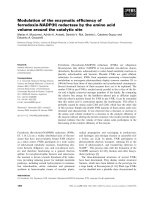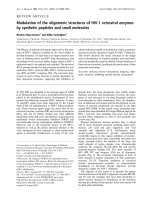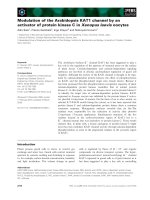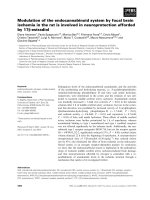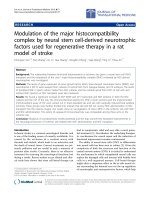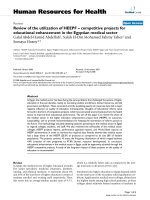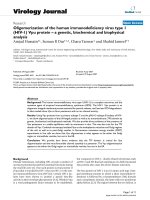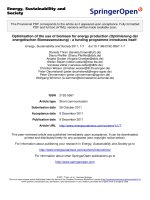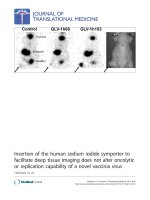Báo cáo sinh học: " Modulation of macrophage functions by sheeppox virus provides clues to understand interaction of the virus with host immune system" docx
Bạn đang xem bản rút gọn của tài liệu. Xem và tải ngay bản đầy đủ của tài liệu tại đây (307.01 KB, 7 trang )
BioMed Central
Page 1 of 7
(page number not for citation purposes)
Virology Journal
Open Access
Research
Modulation of macrophage functions by sheeppox virus provides
clues to understand interaction of the virus with host immune
system
Abdel-Aziz S Abu-EL-Saad
†1
and Ahmed S Abdel-Moneim*
†2
Address:
1
Department of Zoology, Faculty of Science, Cairo University, Beni-Suef, Egypt and
2
Department of Virology, Faculty of Veterinary
Medicine, Cairo University, Beni-Suef 62511, Egypt
Email: Abdel-Aziz S Abu-EL-Saad - ; Ahmed S Abdel-Moneim* -
* Corresponding author †Equal contributors
Abstract
Background: Poxviruses encode a range of immunomodulatory genes to subvert or evade the
challenges posed by the innate and adaptive immune responses. However, the inactivated
poxviruses possessed immunostimulating capacity and were used as a prophylactic or
metaphylactic application that efficiently reduced susceptibility to infectious diseases in different
species. This fact is intensively studied in different genera of poxviruses. However, little is known
about the basic mechanisms adopted by sheeppox virus (SPPV). SPPV causes an acute disease of
sheep that recently, has been observed to reinfect its host in spite of vaccination.
Results: By injecting inactivated or attenuated sheeppox virus SPPV vaccine in adult male Swiss
mice, SPPV was found to reduce macrophages' functions in a local event that occurs at the site of
application 12 h after vaccine administration as indicated by increased level of IL-10 and decreased
level of SOD from cultured peritoneal macrophages. In contrast increased levels of IL-12, and SOD
activity from cultured splenic macrophages, lymphocyte response to PHA-P, and in-vivo response
to T-dependant Ag were detected. These effects were observed in both attenuated and inactivated
SPPV, but more prominent in attenuated one.
Conclusion: The results of this study help to elucidate, the phenomenon of existence natural
SPPV infections in sheep instead of vaccination and the basic mechanisms responsible for the
immunostimulating capacity of sheeppox virus. Locally, SPPV shows evidence for an immune escape
mechanism that alleviates the host's immune response. Later and systemically, the virus protects
the host from any fatal consequences of the immune system suppression.
Background
Sheeppox virus, an epitheliotropic DNA virus, is classified
as a member of Capripox virus genus that represent one of
eight genera within the chordopox virus subfamily of the
Poxviridae. Genus Capripoxvirus is comprised of sheep-
pox virus, goatpox virus, and lumpy skin disease virus that
cause disease in sheep, goats, or cattle, respectively. These
viruses are responsible for some of the most economically
significant diseases of domestic ruminants in Africa and
Asia [9,10]. Live attenuated SPPV and subunit formula-
tions have been used experimentally and in enzootic as
Published: 22 March 2005
Virology Journal 2005, 2:22 doi:10.1186/1743-422X-2-22
Received: 09 March 2005
Accepted: 22 March 2005
This article is available from: />© 2005 Abu-EL-Saad and Abdel-Moneim; licensee BioMed Central Ltd.
This is an Open Access article distributed under the terms of the Creative Commons Attribution License ( />),
which permits unrestricted use, distribution, and reproduction in any medium, provided the original work is properly cited.
Virology Journal 2005, 2:22 />Page 2 of 7
(page number not for citation purposes)
well as outbreak areas as vaccines against sheeppox, goat-
pox, and lumpy skin disease [8,9].
The Poxviridae are the largest known viruses [10] that
have strong immunogenic properties. Poxviruses modu-
late the immune response in infected hosts by inhibiting
the synthesis and release of IL-1 from infected cells;
encoding soluble cytokine receptors for tumor TNF-α,
TNF-β, IL-1, and importantly, IFN-γ; synthesizing virus-
encoded cytokines like epidermal growth factor and trans-
forming growth factor, which antagonize the effects of
host cytokines mediating the antiviral process [16,26]. In
addition, inducing apoptosis in a significant number of
antigen-presenting cells [20] as well as inducing IL-10
release that has the capacity to impair the initiation of an
acquired immune response [16,21]. If the viruses fail to
secrete such immunomodulating proteins, as when the
respective genes are deleted or the viruses are inactivated,
the strong immunogenicity of the viruses may induce host
immune reactions which are no longer inhibited [19].
This is supported by earlier studies revealing enhanced
phagocytosis, natural killer (NK) cell activity, and release
of IFN-α by the use of inactivated poxviruses [7,24]. More-
over, the secretion of TNF-α, IL-2, and granulocyte-macro-
phage colony-stimulating factor could also be enhanced
[23,30]. This assumption leads to the recommendation of
use inactivated poxviruses as prophylactic or metaphylac-
tic tool in reducing susceptibility to infectious diseases
[31]. However, it has been reported recently that inacti-
vated parapoxvirus ovis, was able to induce apoptosis of
antigen-presenting cells (APC) [20].
In this study, sheeppox virus-induced immunomodulat-
ing effects were characterized to elucidate the basic mech-
anisms responsible for understanding the interaction of
SPPV with host immune system. As markers for early
immunological reactions, peritoneal cells were tested after
in vivo treatment with SPPV for IL-10 release and SOD
activities. Markers for late reactions were the proliferation
response of splenocytes to PHA-P, IL-12 release, and SOD
activity, of cultured splenic macrophages from treated
mice. The antibody response to CRBC was also assessed in
different treated groups.
Results
Secretion of IL-10 by peritoneal macrophages
At 12 h post treatment, both vaccinated groups showed
increased IL-10 (P < 0.05) in comparison to placebo.
Attenuated SPPV vaccinated group showed significant (P
< 0.01) increase in comparison to placebo. No significant
variation was observed between the SPPV treated groups
Fig. 1.
IL-10 release from cultured peritoneal macrophages 12 h post SPPV immunizationFigure 1
IL-10 release from cultured peritoneal macrophages
12 h post SPPV immunization. Mice were injected intra-
peritoneally with PBS, inactivated SPPV, or attenuated SPPV.
Peritoneal macrophages were harvested 12 h post inocula-
tion (five/group). Macrophages were co-cultured with LPS 1
µg/ml for 48 h, IL-10 was measured in the culture superna-
tant. Bars represent mean ± S:E:M: of cytokine. SPPV vacci-
nated mice are significantly different from controls at *P <
0.05 or **P < 0.01.
SOD activity of cultured peritoneal macrophages 12 h post SPPV immunizationFigure 2
SOD activity of cultured peritoneal macrophages 12
h post SPPV immunization. Mice were injected intraperi-
toneally with PBS, inactivated SPPV, or attenuated SPPV.
Peritoneal macrophages were harvested 12 h post inocula-
tion (five/group). Macrophages were co-cultured with LPS1
µg/ml for 48 h, SOD was measured in the culture superna-
tant. Bars represent mean ± S:E:M: of SOD. SPPV vaccinated
mice are significantly different from controls at *P < 0.05.
*
**
0
10
20
30
40
50
60
70
80
90
100
Placebo Inac.SPPV Attenu.SPPV
IL-10 ( pg/ml)
Placebo
Inac.SPPV
Attenu.SPPV
*
*
0
10
20
30
40
50
60
70
80
Placebo Inac.SPPV Attenu.SPPV
SOD activity (unit/ml)
Placebo
Inac.SPPV
Attenu.SPPV
Virology Journal 2005, 2:22 />Page 3 of 7
(page number not for citation purposes)
Secretion of SOD by peritoneal macrophages
At 12 h post treatment, both SPPV treated groups showed
significant decreased SOD activity (P < 0.05) in compari-
son to untreated group. No significant variation was
observed between the SPPV treated groups Fig. 2.
Secretion of IL-12 by splenic macrophages
At 6 day post treatment, both SPPV treated groups showed
significant increased IL-12 (P < 0.05) in comparison to
untreated group Fig. 3a. Attenuated SPPV treated group
showed highly significant value (P <0.01) than that
recorded with placebo mice. At 9 day post inoculation
attenuated SPPV treated group showed significant
increased IL-12 secretion (P < 0.01) in comparison to
both inactivated SPPV treated group and untreated one
Fig. 3b.
Splenocytes blastogenic response
No significant variations were detected among different
groups at 12 h, 3 and 6 days post treatment. Significant
increased splenocytes' proliferation response to PHA-P (P
< 0.01) was observed at 9, and 12 days post inoculation in
attenuated SPPV from placebo. Attenuated group showed
significant increased from inactivated group at both 9 (P
> 0.05) and 12 days (P > 0.01). No significant variation
was observed between inactivated SPPV and control
group at 12 day post treatment Table. 1.
Secretion of SOD by splenic macrophages
No significant variations were detected among different
groups at 12 h post treatment. At 3 day post inoculation
significant increased SOD activity was observed (P < 0.01)
in attenuated SPPV in comparison to the other groups.
Significant increased SOD activity (P < 0.05) was observed
at 6 (P < 0.05), 9 (P < 0.01), and 12 (P < 0.01) days post
inoculation in both SPPV treated groups in comparison to
untreated group Table. 2.
IL-12 secretion from cultured splenocytes collected at 6 d (A) ; 9 d (B) post SPPV immunizationFigure 3
IL-12 secretion from cultured splenocytes collected
at 6 d (A) ; 9 d (B) post SPPV immunization. Splenic
macrophages were harvested from mice (five/group), cul-
tured with LPS 1 µg/ml for 48 h. IL-12 was measured in the
culture supernatant. Bars represent mean ± S:E:M: of
cytokine. SPPV vaccinated mice are significantly different
from controls at *P < 0.05 or **P < 0.01.
(A)
*
**
0
5
10
15
20
25
Placebo Inac.SPPV Attenu.SPPV
IL-12 ( pg / ml )
Placebo
Inac.SPPV
Attenu.SPPV
(B)
**
0
10
20
30
40
Placebo Inac.SPPV Attenu.SPPV
IL-12 (pg / ml )
Placebo
Inac.SPPV
Attenu.SPPV
A
B
Table 1: T-cell proliferation based on the MTT dye uptake
method of cultured splenocytes at different intervals post SPPV
immunization
Time post
treatment
Treatment
Placebo Inac.SPPV Atenu. SPPV
12 h 1.22 ± 0.08 1.37 ± 0.14 1.53 ± 0.08
3 d 1.24 ± 0.14 1.39 ± 0.19 1.36 ± 0.18
6 d 1.36 ± 0.09 1.51 ± 0.17 1.45 ± 0.2
9 d 1.16 ± 0.05 1.53 ± 0.08* 2.18 ± 0.12**
12 d 1.78 ± 0.18 1.93 ± 0.05 2.58 ± 0.2**
Splenocytes were harvested from mice (five/group), cultured with
PHA-P (10 µg/well) for 48 h, SI of SPPV treated mice are significantly
different from controls at *P < 0.05 or **P < 0.01.
Table 2: SOD activity of cultured splenocytes' macrophages at
different intervals post SPPV immunization
Time post
treatment
Treatment
Placebo Inac.SPPV Atenu. SPPV
12 h 13.3 ± 1.65 13.6 ± 1.22 12.8 ± 1.35
3 d 12.5 ± 2.8 10.82 ± 2.21 133 ± 23.1**
6 d 10.2 ± 1.79 107.7 ± 25 * 143.7 ± 38*
9 d 52.3 ± 19.1 253.3 ± 33.4** 240.7 ± 42.4 **
12 d 47.6 ± 8.5 266 ± 26.6** 293 ± 37.1**
Splenic macrophages were harvested from mice (five/group).
Macrophages were cultured with LPS (1 µg/ml) for 48 h and SOD was
measured in the culture supernatant. SPPV treated mice are
significantly different from controls at *P < 0.05 or **P < 0.01.
Virology Journal 2005, 2:22 />Page 4 of 7
(page number not for citation purposes)
Immune response to CRBC
Both SPPV treated groups showed significant increase in
haemagglutinating antibody titers to CRBC (P < 0.05) in
comparison to untreated group Fig. 4.
Discussion
Inactivated poxviruses showed immunostimulating
capacity. Such capacity is common to poxviruses of differ-
ent genera [11]. This fact renders poxviruses common vec-
tors in vaccine development. On the other hand,
poxviruses express a wide variety of proteins that are non-
essential for virus replication in vitro but help the virus to
evade the host response to infection that may in turn
impair the immunological response against live viruses.
Such nonstructural proteins includes soluble receptors for
IFNα, β, TNFα, SOD-like protein, etc. [16,26,35]. These
facts together with the recurrence of SPPV infection
among vaccinated flocks [33] let us to study first, the pos-
sible pivotal role of SPPV in inducing local immunosup-
pression as a crucial mechanism of immune escape, and
second, to evaluate the potential beneficial systemic effect
of SPPV on the host immune system.
Early immune response to SPPV at the site of inoculation
provides an explanation for the ability of SPPV to induce
local suppression at site of inoculation as indicated by
increased IL-10 secretion and decreased SOD enzyme
activity 12 h after injection. IL-10, a prototypic anti-
inflammatory cytokine, that inhibits APC function and
ultimately the induction of anti-virus immunity [12], pre-
vents the differentiation of DC from monocytes [5], and
inhibits the down regulation of receptor-mediated endo-
cytosis and macropinocytosis following exposure to a sol-
uble immunogen [25]. In addition, IL-10 reduces the
production of IL-2, IFN and TNF by murine Th1 cells [14]
as well as the IL-12 production by APC [18]. IL-10 may
also, intervene at the level of antigen processing within
the cell so that antigen is not degraded effectively and
MHC class II molecules fail to load with peptide [13].
Accordingly, enhanced secretion of IL-10 by SPPV has the
capability to inhibit antigen presenting cell (APC) func-
tion as well as innate response and hence impairing the
initiation of an acquired immune response. Such effect
inhibits the generation of immunological memory neces-
sary to immunity in subsequent exposure [2]. Interest-
ingly, both inactivated and attenuated SPPV showed
significant increase in the IL-10 production from perito-
neal macrophages. On the other hand, decreased in vitro
SOD activity of cultured peritoneal macrophages noticed
in SPPV treated groups may also enhance in vivo virus sur-
vival in, and in the presence of phagocytes. Superoxide is
generated deliberately by phagocytes during the respira-
tory burst to kill microorganisms [3]. The regulation of
cellular SOD in poxvirus-infected cells might disrupt the
balance of oxidants and antioxidants. Superoxide radicals
arise during numerous oxidations in both living and non-
living systems and can act directly as oxidants or generate
other reactive products that are toxic to cells, causing dam-
age to lipid membranes, nucleic acid, carbohydrates, and
proteins. SOD scavenges active oxygen species generated
during aerobic metabolism. Consequently, aerobic exist-
ence is accompanied by a persistent state of oxidative
siege, and the survival of a given cell is determined by its
balance of reactive oxygen intermediates and antioxi-
dants. Disturbance of this balance can lead to disease [17].
Further, since oxidative stress can induce apoptosis [6],
this may aid virus dissemination, a fact recorded with
other poxviruses [20]. Additionally, an increase in the cel-
lular oxidant status results in activation of transcriptional
factors, such as NF-κB [28], that may be necessary for rep-
lication of some viruses [27,37]. Virulent viruses of SPPV
may advocate similar immune evasion mechanisms that
deflect down regulation and abortion of cell-mediated
immunity.
In order to gain more insight into the processes underly-
ing the possible immune stimulating effect of vaccination
with SPPV, the ex-vivo levels of IL-12, SOD in splenic
macrophages, and the magnitude of splenocyte prolifera-
tive response to PHA-P as well as the in-vivo effect of SPPV
on humoral immune response to TD Ag; CRBC were stud-
ied. The obtained data showed that mice successfully vac-
cinated with SPPV displayed significant increases in IL-12
levels at 6 and 9 days post vaccination as compared to
unvaccinated mice. IL-12 was examined at that time as it
Humoral antibody response to CRBCFigure 4
Humoral antibody response to CRBC. Mice were
treated with live or inactivated SPPV or placebo. At 7 day,
P.I., CRBC were administered by i.p route of inoculation.
Seven days later, haemagglutinating abs were measured by
HA test. SPPV treated mice are significantly different from
controls at *P < 0.05.
*
*
0
1
2
3
4
5
6
Placebo Inac.SPPV Attenu.SPPV
Log
2
Titers
Placebo
Inac.SPPV
Attenu.SPPV
Virology Journal 2005, 2:22 />Page 5 of 7
(page number not for citation purposes)
is likely that a minimum of five days is required to create
an effective barrier by poxvirus-mediated T-cell activation
and cytokine secretion [11]. Interestingly, SOD, and lym-
phocyte blastogenesis as well as humoral immune
response to CRBC were significantly enhanced in SPPV
vaccinated mice especially in group treated with attenu-
ated SPPV that may be related to virus replication.
Enhanced splenic T-lymphocyte response to PHA-P in
vaccinated mice indicates that SPPV may help in main-
taining optimum T-cell responsiveness after vaccination.
These effects might also rely on increased amounts of
SPPV induced enhancement of IL-12 due to ability of IL-
12 to induce early phase of NK and T cell activation [34].
Using CRBC as model of TD Ag, it has been shown that
SPPV was capable of enhancing TD Ab responses. Interest-
ingly, enhancement was observed in mice vaccinated with
either inactivated or attenuated SPPV. Furthermore,
enhancement of lymphocyte blastogenesis and SOD were
also recorded. These results are the first to demonstrate an
immunostimulant effect of SPPV. Enhanced responses to
TD Ags in SPPV vaccinated mice may be due to the
enhancement of IL-12 production, increased responsive-
ness of T-lymphocyte and the SOD activity that were
recorded in this study. IL-12 enhancement may initiate
such cascade as it has been found to be the dominant fac-
tor in development of the Th1 phenotype and also
directly, or from its associated release of type-1 cytokines,
enhances the activation and production of Th1-associated
immunoglobulins [1]. In addition, IL-12 is not only a
connective element between accessory cells and lym-
phocytes, but it is also a key molecule for programming
the macrophage and dendritic cell functions [4]. One of
the major effects of IL-12 on macrophages and dendritic
cells is the induction of IFN-γ, resulting in a positive feed-
back capable of activating them in different situations
[15].
Our observations indicate that the SPPV-induced reduced
macrophages' functions in a local event that occurs at the
site of application 12 h after administration. In contrast, 3
till 12 days after injection of either inactivated or attenu-
ated SPPV, enhanced functions of splenic macrophages
and increased responsiveness of lymphocytes were found
to be significantly increased that was more pronounced in
attenuated vaccine rather than inactivated one. The
combination of suppressive and stimulatory mechanisms
is a complicated blend of viral survival strategy.
Conclusion
Locally, SPPV shows evidence for an immune escape
mechanism that alleviates the host's immune response to
viral proteins and therefore generates the possibility of
replicating in the host in spite of vaccination. Such sug-
gested enhanced replication strategy appears to be essen-
tial for the continued existence of SPPV. Surprisingly,
injection of inactivated SPPV produced similar effect but
to a lower extent that denotes: evading host immune
response by SPPV is not dependent on virus infectivity.
Later and systemically, the virus protects the host from
any fatal consequences of the suppression of the immune
system by compensatory enhanced activities of splenic
macrophages and lymphocytes. This cascade of immuno-
logical events would be an excellent strategy for the virus
to survive.
Methods
Animals
Eight-week-old Swiss male mice (Biological Supply
Center, Theodar Bilharz Research Institute (TBRI), Cairo,
Egypt) were used within this study. Mice were bred con-
ventionally, and received standard laboratory diet as well
as water ad libitum.
Virus
SPPV attenuated vaccine (Vaccine and Sera Production
and Research Institute, Abbasia, Cairo, Egypt) was used.
The Vaccine was reconstituted in 2 ml sterile PBS (pH
7.4), titrated on the chorioallantoic membrane of 10-day-
old specific pathogen free embryonated chicken eggs
(Nile SPF, Koom Oshiem, Fayoum, Egypt). Half of the
stock virus preparation was inactivated using β propiolac-
tone as previously described [23].
Animal inoculation
Ninety mice were divided into three groups (30 mice per
group). Mice in group 1 and 2 were inoculated with 10
7
EID
50
/0.2 ml of inactivated and attenuated SPPV vaccine,
respectively by i.p. route of inoculation. Mice in group 3
were kept as a placebo and inoculated with sterile PBS by
the same route.
Analyses of IL-10 and SOD from cultured peritoneal
macrophages
The peritoneal macrophages were collected 12 h post i.p.
inoculation of SPPV by peritoneal lavage. Cells were
washed twice with sterile PBS, incubated in 24-well plate
(Costar, Cramlington, U.K.) at a concentration of 1 × 10
6
cells/ml in RPMI 1640 (Gibco Laboratories, Grand
Islands, NY) for 4 h at 37°C in a 5% CO
2
tension. Non
adherent cells were removed by three repeated washings
and peritoneal macrophages incubated with lipopolysac-
charide 1 µg/ml (Sigma Chemical Co., USA) for 48 h at
37°C. At the end of incubation time, culture supernatants
were collected, clarified by low speed centrifugation at
250 g for 10 min, and kept at -20°C until processing for
IL-10, using mouse IL-10 immunoassay kit (BioSource
International Inc. USA) according to manufacture instruc-
tions. SOD activity was also assessed in peritoneal macro-
phages' culture supernatants by means of the inhibition of
pyrogallol autoxidation as described [22]. One unit of
Virology Journal 2005, 2:22 />Page 6 of 7
(page number not for citation purposes)
SOD activity is defined as the amount of enzyme required
to inhibit autoxidation by 50% at 25 °C.
Splenocytes preparation
Proliferation assay was conducted at 12 h, 3, 6, 9, 12 days
post SPPV inoculation. Spleens were aseptically removed
and placed in ice cold sterile PBS, (pH 7.4). Each spleen
was squeezed with a 5 ml syringe plunger to extrude cells.
Cell suspensions were centrifuged at 250 g for 10 min.
Pelleted cells were resuspended in 5 ml of lysing buffer
(Tris 0.17 M and ammonium chloride 0.16 M, pH 7.2)
and incubated at room temperature for 5 min to lyse the
red blood cells. Cell suspensions were washed twice with
PBS and cell viability determined using trypan blue dye
exclusion method.
Splenocyte Proliferation Assay
Splenocytes were suspended in RPMI-1640 containing
10% FCS. One hundred micro-liters of suspended cells (1
× 10
5
cells per 100 ul) were added to each well of 96-well
microtiter plate (Costar, Cramlington, U.K.). Splenocytes
were stimulated with PHA-P (Sigma, Chemical Co.USA)
at a final concentration of 10 ug/well. Cell cultures were
incubated for 48 h at 37°C with 5% CO
2
tension. Spleno-
cyte proliferation was measured using 3-(4,5-dimethylth-
iazol-2-yl)-2,5-diphenyl tetrazolium bromide (MTT) dye
uptake method as described [32]. The lymphocyte blast-
ogenesis was expressed as stimulation index (SI): SI (%) =
A2-A0/A1-A0. A2 is the absorption of cultures with PHA-
P; A1 is the absorption of cultures without mitogen; A0 is
absorption of the blank (culture medium only).
Analyses of IL-12 and SOD from cultured splenocytes
The splenic macrophages were incubated in 24-well plate
at a concentration of 1 × 10
6
cell/ml in RPMI 1640 for 4 h
at 37°C in a 5% CO
2
tension. Non adherent cells were
removed by three repeated washings and splenic macro-
phages were incubated with lipopolysaccharide 1 µg/ml
for 48 h at 37°C. At the end of incubation time, culture
supernatants were collected, and kept at -20°C until
processing for IL-12 using mouse IL-12 immunoassay kit
(BioSource International Inc. USA) according to manufac-
ture instructions. The assay recognizes both natural and
free p40 subunit. SOD was also assessed as previously
described.
Effect of SPPV on the immune response to CRBC
Mice in all groups were inoculated i.p. with 1 × 10
7
CRBC
at day 7. Serum was obtained seven days after CRBC
immunization, tested for agglutinins against CRBC by the
microhaemagglutination test according to [36].
Statistical analysis
Analysis of variance (ANOVA) test was done for differ-
ences between treated groups according to [29].
List of Abbreviations
Ab, antibody; Ag, antigen; Ags, antigens; attenu., attenu-
ated; APC, antigen presenting cell; CRBC, chicken red
blood cells; DC, dendritic cell; Th; T-helper; IL, inter-
leukin; inac., inactivated; INF, interferon; NK, natural
killer cell; PHA-P, phytohaemagglutinin-P; SOD, superox-
ide dismutase; SPPV, sheeppox virus;SI, stimulation
index; TD, T-dependent; TNF, tumour necrosis factor.
Competing interests
The author(s) declare that they have no competing
interests.
Authors' contributions
Abu-El-Saad participated in the design of the study, car-
ried out the work with the mice, assisted in experimental
work and drafting of the manuscript. Abdel-Moneim con-
ceived the study, designed and carried out the experimen-
tal work and drafted the manuscript. All authors read and
approved the final manuscript.
References
1. Airoldi I, Gri G, Marshall JD, Corcione A, Facchetti P, Guglielmino R,
Trinchieri G, Pistoia V: Expression and function of IL-12 and IL-
18 receptors on human tonsillar B cells. J Immunol 2000,
165:6880-6888.
2. Alcami A, Koszinowski UH: Viral mechanisms of immune
evasion. Mol Med Today 2000, 6:365-372.
3. Babior BM: The respiratory burst oxidase. Trends Biochem Sci
1987, 12:241-243.
4. Bastos KRB, Marinho CRF, Barboza R, Russo M, Álvarez JM,
D'Império Lima MR: What kind of message does IL-12/IL-23
bring to macrophages and dendritic cells? Microbes and Infection
2004, 6:630-636.
5. Buelens C, Verhasselt V, De Groote D, Thielemans K, Goldman M,
Willems F: Interleukin-10 prevents the generation of dendritic
cells from human peripheral blood mononuclear cells cul-
tured with interleukin-4 and granulocyte/ macrophage-col-
ony-stimulating factor. Eur J Immunol 1997, 27:756-762.
6. Buttke TM, Sandstrom PA: Oxidative stress as a mediator of
apoptosis. Immunol Today 1994, 15:7-10.
7. Büttner M, Czerny CP, Lehner KH, Wertz K: Interferon induction
in peripheral blood mononuclear leukocytes of man and
farm animals by poxvirus vector candidates and some poxvi-
rus constructs. Vet Immunol Immunopathol 1995, 46:237-250.
8. Capstick PB, Coackley W: Protection of cattle against lumpy
skin disease. Res Vet Sci 1961, 2:362-375.
9. Carn VM: Control of capripoxvirus infections. Vaccine 1993,
11:1275-1279.
10. Esposito JJ, Fenner F: Poxviruses. In Fields virology 4th edition. Edited
by: Fields, BN, Knipe DM, Howley PM, Chanock RM, Melnick JL,
Monathy TP, Roizman B, Straus SE. Philadelphia, Pa:Lippincott, Wil-
liams and Wilkins; 2001:2885-2921.
11. Fachinger V, Schlapp T, Strube W, Schmeer N, Saalmuller A: Poxvi-
rus-induced immunostimulating effects on porcine
leukocytes. J Virol 2000, 74:7943-7951.
12. Fickenscher H, Hör S, Küpers H, Knappe A, Wittmann S, Sticht H:
The interleukin-10 family of cytokines. Trends Immunol 2002,
23:89-96.
13. Fiebiger E, Meraner P, Weber E, Fang IF, Stingl G, Ploegh H, Maurer
D: Cytokines regulate proteolysis in major histocompatibil-
ity complex class II-dependent antigen presentation by den-
dritic cells. J Exp Med 2001, 193:881-892.
14. Fiorentino DF, Bond MW, Mosmann TR: Two types of mouse T
helper cell. IV. Th2 clones secrete a factor that inhibits
cytokine production by Th1 clones. J Exp Med 1989,
170:2081-2095.
Publish with Bio Med Central and every
scientist can read your work free of charge
"BioMed Central will be the most significant development for
disseminating the results of biomedical research in our lifetime."
Sir Paul Nurse, Cancer Research UK
Your research papers will be:
available free of charge to the entire biomedical community
peer reviewed and published immediately upon acceptance
cited in PubMed and archived on PubMed Central
yours — you keep the copyright
Submit your manuscript here:
/>BioMedcentral
Virology Journal 2005, 2:22 />Page 7 of 7
(page number not for citation purposes)
15. Frucht DM, Fukao T, Bogdan C, Schindler H, O'Shea JJ, Koyasu S:
IFN-gamma production by antigen-presenting cells: mecha-
nisms emerge. Trends Immunol 2001, 22:556-560.
16. Haig DM: Poxvirus interference with the host
cytokineresponse. Vet Immunol Immunopathol 1998, 63:149-156.
17. Halliwell B, Gutteridge JMC: Free radicals in biology and medicine 3rd
edition. Oxford University Press, Oxford, United Kingdom; 1999.
18. Huang LY, Reise Sousa C, Itoh Y, Inman J, Scott DE: IL-12 induction
by a TH1-inducing adjuvant in vivo: dendritic cell subsets and
regulation by IL-10. J Immunol 2001, 167:1423-1430.
19. Huang S, Hendriks W, Althage A, Hemmi S, Bluethmann H, Kamijo R,
Vilcek J, Zinkernagel RM, Aguet M: Immune response in mice
that lack the interferon-gamma receptor. Science 1993,
259:1742-1745.
20. Kruse N, Weber O: Selective induction of apoptosis in antigen-
presenting cells in mice by parapoxvirus ovis. J Virol 2001,
75:4699-4704.
21. Lateef Z, Fleming S, Halliday G, Faulkner L, Mercer A, Baird M: Orf
virus-encoded interleukin-10 inhibits maturation, antigen
presentation and migration of murine dendritic cells. J Gen
Virol 2003, 84:1101-1109.
22. Marklund S, Marklund G: Involvement of the superoxide anion
radical in the autooxidation of pyrogallol and a convenient
assay for superoxide dismutase. Eur J Biochem 1974, 47:469-474.
23. Mayr A, Büttner M, Wolf G, Meyer H, Czerny C: Experimental
detection of the paraspecific effects of purified and inacti-
vated poxviruses. Zentralbl Veterinarmed B 1989, 36:81-99.
24. Mayr A, Büttner M, Pawlas S, Erfle V, Mayr B, Brunner R, Osterkorn
K: Comparative studies of the immunostimulating (paramu-
nizing) effectiveness of BCG, levamisole, Corynebacterium
parvum and preparations of pox viruses in various in vivo and
in vitro tests. Zentralbl Veterinarmed B 1986, 33:321-339.
25. Morel AS, Quaratino S, Douek DC, Londei M: Split activity of
interleukin-10 on antigen capture and antigen presentation
by human dendritic cells: definition of a maturative step. Eur
J Immunol 1997, 27:26-34.
26. Pickup DJ: Poxviral modifiers of cytokine responses to
infection. Infect Agents Dis 1994, 3:116-127.
27. Ritter K, Kuhl RJ, Semrau F, Eiffert H, Kratzin HD, Thomssen R: Man-
ganese superoxide dismutase as a target of autoantibodies in
acute Epstein-Barr virus infection. J Exp Med 1994,
180:1995-1998.
28. Schreck R, Rieber P, Baeuerle PA: Reactive oxygen intermedi-
ates as apparently widely used messengers in the activation
of the NF-κB transcription factor and HIV-1. EMBO J 1991,
10:47-2258.
29. Steel RGD, Torrie JH: Principles and procedures of statistics New York:
McGraw-Hill Book Comp. Inc. Toronto, London; 1960:99-131.
30. Steinmassl M, Wolf G: Formation of interleukin-2 and inter-
feron alpha by mononuclear leukocytes of swine after in
vitro stimulation with different virus preparations. Zentralbl
Veterinarmed B 1990, 37:321-331.
31. Strube W, Kretzdorn D, Grunmach J, Bergle RD, Thein P: The effec-
tiveness of the paramunity inducer Baypamun (PIND-ORF)
for the prevention and metaphylaxis of an experimental
infection with the infectious bovine rhinotracheitis virus in
cattle. Tierarztl Prax 1989, 17:267-272.
32. Tada H, Shiho O, Kuroshima K, Koyama M, Tsukamoto K: An
improved colorimetric assay for interleukin 2. J Imm Meth
1986, 93:157-165.
33. Tamam SM, (Ed): Isolation of sheep pox virus from naturally
infected sheep with a history of previous vaccination with
sheep pox virus (SPV) vaccine. In Proceedings of the tenth Confer-
ence 5–7 November 1996 Faculty of Veterinary Medicine, Assiut Uni-
vrsity, Egypt; 1996:111-118.
34. Trinchieri G: Interleukin-12 and the regulation of innate resist-
ance and adaptive immunity. Nat Rev Immunol 2003, 3:133-146.
35. Tulman ER, Afonso CL, Lu Z, Zsak L, Sur J-H, Sandybaev NT, Kerem-
bekova UZ, Zaitsev VL, Kutish GF, Rock DL: The genomes of
sheeppox and goatpox viruses. J Virol 2002, 76:6054-6061.
36. Wegman TG, Smithies O: A simple haemagglutination system
requiring small amounts of red cells and antibodies. Transfu-
sion 1966, 6:67-73.
37. Westendorp MO, Shatrov VA, Schulze-Osthoff K, Frank R, Kraft M,
Los M, Krammer PH, Droge W, Lehmann V: HIV-1 Tat potenti-
ates TNF-induced NF-κB activation and cytotoxicity by
altering the cellular redox state. EMBO J 1995, 14:546-554.
